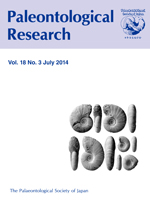Calyptraphorus is a distinctive stromboidean gastropod genus with its earliest fossil record from the Campanian (Cretaceous). The genus survived the K-Pg biotic crisis and was thought to have become extinct before the end of the Eocene. Calyptraphorus sp. is described on the basis of a single specimen recovered from the mid-Pliocene Tartaro Formation in northern Luzon, the Philippines. The specimen is similar to Eocene congeners recorded from the southeastern United States and Pakistan. It is left unnamed because the single available specimen is too incomplete for comparison with other known species. The significance of this discovery is that it extends the recorded stratigraphic range of the genus from the end of the Eocene to the Pliocene, leaving a hiatus of approximately 30 Myr, which classifies Calyptraphorus sp. as a Lazarus taxon. The genus apparently survived as a refugee taxon in the tropical Western Pacific, keeping the population density very low and/or the geographic distribution limited to small areas after the Eocene biotic crisis.
BioOne.org will be down briefly for maintenance on 17 December 2024 between 18:00-22:00 Pacific Time US. We apologize for any inconvenience.
How to translate text using browser tools
1 July 2014
The Gastropod Genus Calyptraphorus (Rostellariidae: Stromboidea: Mollusca): A Lazarus Taxon from the Pliocene of the Philippines
Tomoki Kase,
Yolanda M. Aguilar
ACCESS THE FULL ARTICLE

Paleontological Research
Vol. 18 • No. 3
July 2014
Vol. 18 • No. 3
July 2014
Calyptraphorus
Gastropoda
Lazarus taxa
Philippines
Pliocene
Rostellariidae




